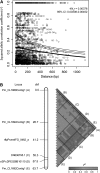Multilocus patterns of nucleotide diversity and divergence reveal positive selection at candidate genes related to cold hardiness in coastal Douglas Fir (Pseudotsuga menziesii var. menziesii)
- PMID: 19596906
- PMCID: PMC2746152
- DOI: 10.1534/genetics.109.103895
Multilocus patterns of nucleotide diversity and divergence reveal positive selection at candidate genes related to cold hardiness in coastal Douglas Fir (Pseudotsuga menziesii var. menziesii)
Abstract
Forest trees exhibit remarkable adaptations to their environments. The genetic basis for phenotypic adaptation to climatic gradients has been established through a long history of common garden, provenance, and genecological studies. The identities of genes underlying these traits, however, have remained elusive and thus so have the patterns of adaptive molecular diversity in forest tree genomes. Here, we report an analysis of diversity and divergence for a set of 121 cold-hardiness candidate genes in coastal Douglas fir (Pseudotsuga menziesii var. menziesii). Application of several different tests for neutrality, including those that incorporated demographic models, revealed signatures of selection consistent with selective sweeps at three to eight loci, depending upon the severity of a bottleneck event and the method used to detect selection. Given the high levels of recombination, these candidate genes are likely to be closely linked to the target of selection if not the genes themselves. Putative homologs in Arabidopsis act primarily to stabilize the plasma membrane and protect against denaturation of proteins at freezing temperatures. These results indicate that surveys of nucleotide diversity and divergence, when framed within the context of further association mapping experiments, will come full circle with respect to their utility in the dissection of complex phenotypic traits into their genetic components.
Figures



Similar articles
-
Association genetics of coastal Douglas fir (Pseudotsuga menziesii var. menziesii, Pinaceae). I. Cold-hardiness related traits.Genetics. 2009 Aug;182(4):1289-302. doi: 10.1534/genetics.109.102350. Epub 2009 Jun 1. Genetics. 2009. PMID: 19487566 Free PMC article.
-
A catalogue of putative unique transcripts from Douglas-fir (Pseudotsuga menziesii) based on 454 transcriptome sequencing of genetically diverse, drought stressed seedlings.BMC Genomics. 2012 Nov 28;13:673. doi: 10.1186/1471-2164-13-673. BMC Genomics. 2012. PMID: 23190494 Free PMC article.
-
Nucleotide diversity and linkage disequilibrium in cold-hardiness- and wood quality-related candidate genes in Douglas fir.Genetics. 2005 Dec;171(4):2029-41. doi: 10.1534/genetics.105.044420. Epub 2005 Sep 12. Genetics. 2005. PMID: 16157674 Free PMC article.
-
An Axiom SNP genotyping array for Douglas-fir.BMC Genomics. 2020 Jan 3;21(1):9. doi: 10.1186/s12864-019-6383-9. BMC Genomics. 2020. PMID: 31900111 Free PMC article.
-
Dissecting the Polygenic Basis of Cold Adaptation Using Genome-Wide Association of Traits and Environmental Data in Douglas-fir.Genes (Basel). 2021 Jan 18;12(1):110. doi: 10.3390/genes12010110. Genes (Basel). 2021. PMID: 33477542 Free PMC article.
Cited by
-
Predicting adaptive phenotypes from multilocus genotypes in Sitka spruce (Picea sitchensis) using random forest.G3 (Bethesda). 2012 Sep;2(9):1085-93. doi: 10.1534/g3.112.002733. Epub 2012 Sep 1. G3 (Bethesda). 2012. PMID: 22973546 Free PMC article.
-
What can patterns of differentiation across plant genomes tell us about adaptation and speciation?Philos Trans R Soc Lond B Biol Sci. 2012 Feb 5;367(1587):364-73. doi: 10.1098/rstb.2011.0199. Philos Trans R Soc Lond B Biol Sci. 2012. PMID: 22201166 Free PMC article. Review.
-
Neutral and adaptive drivers of microgeographic genetic divergence within continuous populations: the case of the neotropical tree Eperua falcata (Aubl.).PLoS One. 2015 Mar 25;10(3):e0121394. doi: 10.1371/journal.pone.0121394. eCollection 2015. PLoS One. 2015. PMID: 25807272 Free PMC article.
-
Spatially heterogeneous selection and inter-varietal differentiation maintain population structure and local adaptation in a widespread conifer.BMC Ecol Evol. 2024 Sep 3;24(1):117. doi: 10.1186/s12862-024-02304-4. BMC Ecol Evol. 2024. PMID: 39227766 Free PMC article.
-
Impact of Geography and Climate on the Genetic Differentiation of the Subtropical Pine Pinus yunnanensis.PLoS One. 2013 Jun 26;8(6):e67345. doi: 10.1371/journal.pone.0067345. Print 2013. PLoS One. 2013. PMID: 23840668 Free PMC article.
References
-
- Aitken, S. N., and W. T. Adams, 1996. Genetics of fall and winter cold hardiness of coastal Douglas-fir in Oregon. Can. J. For. Res. 26: 1828–1837.
-
- Aitken, S. N., and W. T. Adams, 1997. Cold hardiness under strong genetic control in Oregon populations of Pseudotsuga menziesii var. menziesii. Can. J. For. Res. 27: 1773–1780.
Publication types
MeSH terms
LinkOut - more resources
Full Text Sources

